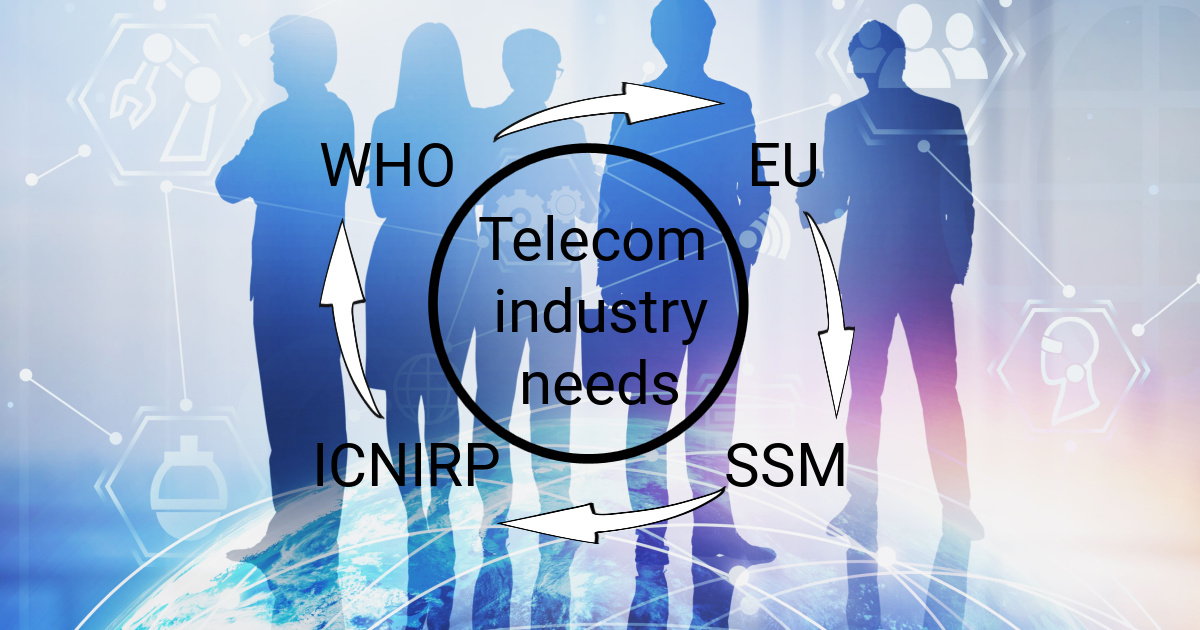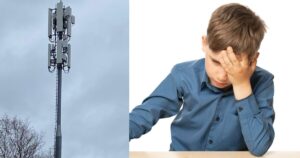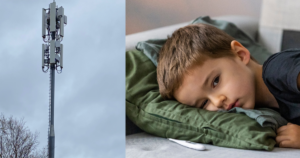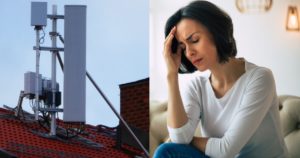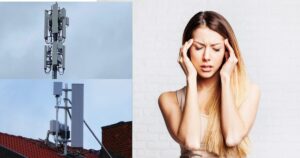Since 2002, the Swedish Radiation Safety Authority (SSM) has engaged experts on health effects from RF radiation and electromagnetic fields with conflicts of interests. Most of them are part of a cartel of experts who receives research funding from the telecom companies and/or are members of ICNIRP that sets radiation exposure limits favorable to the telecommunications industry. These so called ICNIRP cartel experts also dominate expert investigations for the WHO and the EU Commission. Their conclusions are always favorable to the telecom industry.
For 20 years, the SSM has engaged a group of experts with clear conflicts of interest. The expert group created in 2002 has for 20 years been dominated by members of ICNIRP and experts having received funding for research from the telecommunications industry.
During the same time period SSM never consulted any scientist representing the large group of field scientists who acknowledge there are health risks at levels significantly lower than the ICNIRP limits and that better protection is needed.
Each year this expert group, first called The International Independent Expert Group on Electromagnetic Fields, and during the last ten years renamed the SSM Scientific Council on Electromagnetic Fields, published an expert report in English with conclusions favorable to the ICNIRP limits and the telecommunications industry. The reports are available here.
The very same experts with an opinion favorable to the telecommunications industry also reappear in other influential expert groups, for instance at the WHO, the EU Commission and ICNIRP.
Why is it a conflict of interest to be a member of ICNIRP?
ICNIRP is a German-based organization that recommended the limits for permissible microwave or radiofrequency radiation from base stations and mobile phones, which in turn are recommended by the European Commission and the WHO. Most countries around the world have adopted the ICNIRP 1998 limits, for instance Sweden. In 2020 ICNIRP recommended new limits allowing even more radiation exposure. These values are economically important for the telecom companies and the military industry. The telecom companies have therefore lobbied for many years for the adoption of the ICNIRP limits, despite the fact that they are clearly outdated and seriously inadequate to protect against adverse health and environmental effects. A clear majority of field Scientists conclude that the ICNIRP limits must be significantly reduced. These latter group of experts have no ties to the industry concerned, unlike most members of ICNIRP and the SSM, the WHO and the EU Commission expert groups. Being both a member of ICNIRP and act as expert for SSM, WHO or the EU Commission and evaluating the research and the adequacy of the ICNIRP limits is undoubtedly a conflict of interest, particularly considering the huge economic interests embedded in the ICNIRP limits.
A study commissioned by two members of the European Parliament published in 2020 found that ICNIRP’s links to the telecoms companies implies that the organization cannot be considered independent. Over the years, a large number of ICNIRP members have received research funding from the industries (telecoms, electricity, military) that benefit from ICNIRP’s high industry-friendly limits.
Why is it a conflict of interest to receive research funding from industry?
Telecom companies pay for research that they expect will give them favorable outcomes. Investigations, not only concerning the issue of health risks from wireless radiation but also outcomes of research on environmental toxins and pharmaceuticals, show that the research funded by the telecoms or any industry with commercial or strategic interests in the outcome of the research most often shows results favorable to the industry. For instances food and pharmaceutical industry–sponsored research are more likely to present results and conclusions that favor the sponsor’s product. Research can be designed from the outset in a way that favors a positive outcome for industry.
Research funded by the Swiss foundation FSM, the Swiss Research Foundation for Electricity and Mobile Communication, which acts as an intermediary between industry and researchers, nearly always report results that are favorable to industry. One striking example is a study on the risk of brain tumours among children using mobile phones (Cefalo) where there was clear manipulation of the study that would bend the results towards no risks and biased reporting of the obtained results. Several of the Cefalo scientists are also members of ICNIRP and the cartel of experts biased towards telekom industry needs.
The members of the Swedish expert group
Five out of seven members of the SSM Scientific Council on Electromagnetic Fields 2022 are members of or advisory experts to ICNIRP. Five out of seven experts have also received funding for research from the FSM:
Anke Huss, member of ICNIRP. Has received funding from the FSM, the Swiss foundation which in turn is funded by telecoms and electricity companies.
Aslak Harbo Poulsen, co-author of a Danish study on brain tumor risk from mobile phone use (so called Danish cohort), originally funded by Danish telecom companies that was designed to find no risks. He is also co-author of the manipulated Cefalo-study funded by FSM.
Clemens Dasenbrock, advisory expert ICNIRP, former). He has received funding for research from FSM. He was also one of few experts that wrote the SCHEER report to the EU Commission that recommended adoption of ICNIRP limits.
Eric van Rongen, chairman of ICNIRP (2016-2020) and member of IEEE/ICES an industry organization for many years.
Heidi Danker-Hopfe, received funding from FSM, the Swiss foundation funded by telecoms and electricity companies. She was also one of few experts that wrote the SCHEER report to the EU Commission that recommended adoption of ICNIRP limits.
Maria Scarfi, advisory expert to ICNIRP since 2006.
Martin Röösli, ICNIRP member, funded by FSM, the Swiss foundation funded by telecoms and electricity companies.
The ‘independent’ expert group with conflicts of interest
In 2002, SSM (then called the Swedish Radiation Protection Authority, SSI) appointed an allegedly ‘independent’ international expert group with clear conflicts of interest. The group was chaired by Anders Ahlbom, a professor at the Institute of Environmental Medicine, Karolinska Institute, who was a member of ICNIRP since 1996 (until 2008). At the same time his brother Gunnar Ahlbom was vice-president EU Affairs for the largest Swedish telecom operator Telia in Brussels, thus a lobbyist. Anders Ahlbom was tasked with producing an annual report reviewing new research to guide the Director-General of the SSM on the health effects of electromagnetic fields and mobile phone radiation. Anders Ahlbom appointed his close colleague Maria Feychting, also a member of ICNIRP, as secretary. He also appointed six other experts to be members of this allegedly ‘independent’ expert group. Most of them were members of ICNIRP or had received funding from the telecom or electricity industry, thus from industries with strategic interests in the outcome of the group’s evaluations.
It did not become publicly known until almost ten years later that Anders Ahlbom’s brother, Gunnar Ahlbom, was a lobbyist for the telecom operator Telia in Brussels, a company with strong interests in maintaining the ICNIRP limits and dismissing the health risks of radiation from the technology. In 1999 Gunnar Ahlbom was interviewed in Aftonbladet in his role of a lobbyist for Telia in Brussels.
Maria Feychting was a member of ICNIRP since 2000. Both she and Ahlbom have received research funding from telecoms companies. A majority or at least half of the other members of the Scientific Council have always been members of ICNIRP, thus guaranteeing a conclusion favorable to the industry and the ICNIRP limits.
Below is the composition of SSM’s “independent” expert group in 2002:
Anders Ahlbom, member ICNIRP (since 1996), brother Gunnar Ahlbom lobbyist Telia in Brussels (since 1990’s), funding from telecom companies (MMF, GSM Association, Ericsson, Telia).
Maria Feychting, member ICNIRP (since 2000), funding from telecoms companies (MMF, GSM Association, Ericsson, Telia).
Jukka Juttilainen, member of ICNIRP (since 2004), funding from telecoms companies (MMF, GSM Association).
Bernhard Veyret, member ICNIRP (since 2000), funding from telecoms companies (MMF, GSM association and others).
Harri Vainio
Leeka Kheifets, member ICNIRP (since 2004), funding from electricity companies (EPRI).
Eduard David
Malcolm Harrington, funding from electricity companies (National Grid Company and others))
Had conflict of interest – resigned
In 2011, it was revealed that Anders Ahlbom had not declared that he was on the board of directors of his brother and Telia’s former lobbyist Gunnar Ahlbom’s consulting company Gunnar Ahlbom AB ahead of his role as chair of the epidemiological expert group on cancer risk assessment for the WHO’s cancer research institute, IARC. Not once since his appointment as chairman of the allegedly “independent” expert group at SSM in 2002 had Anders Ahlbom declared that his brother had been a lobbyist for Telia in Brussels since the 1990s. Nor when he led the European Commission’s expert group SCENIHR on the issue in 2007, nor when he participated in the same EU expert group two years later in 2009. Nor did he declare this conflict of interest when he acted as an expert for the WHO EMF Project during the same time period . However the WHO also did not declare until 2006, that the EMF Project at the WHO was funded by the telecom organisations GSM Association and MMF for the WHO’s work on the issue of radiation from wireless technology between 1996 and 2006. Telia is one of several members of GSM Association.
After the revelation of his involement in his brother’s consultancy company in 2011, Ahlbom was kicked out of the IARC expert evaluation and left the SSM “independent” expert group. At the same time, his colleague Maria Feychting resigned from the ‘independent’ expert group. Since that incident, the SSM changed the name of the expert group from “independent” international expert group to “Scientific Council on Electromagnetic Fields”. The expert group has nevertheless remained dominated by members from ICNIRP (see above members in 2023).
The WHO funded by telecoms – ICNIRP chairman project manager
The project leader for the WHO’s work on the issue during the period 1996 and 2006, Michael Repacholi, was also the first chairman of ICNIRP and co-author of ICNIRP’s extremely high limits or “guidelines” first published in 1998. During his time at the WHO, Repacholi, with the help of Anders Ahlbom and other ICNIRP members, promoted the ICNIRP limits as the gold standard throughout the world in a so-called “harmonization” project. A number of conferences were organized for this purpose over the world, always together with representatives of the telecom companies. This ICNIRP propaganda campaign claiming that there were no health effects below the ICNIRP limits, were conducted by the WHO, and apparently paid for partly by the telecommunications industry. Half the funding for the WHO EMF project under the leadership of the former ICNIRP chairman Michael Repacholi, came from telecommunications organizations such as GSM Association and Mobile Manufacturer’s Forum. The ICNIRP limits were promoted as safe depite the intriguing fact that the Director-General of the WHO until 2002, Gro Harlem Brundtland, a trained medical doctor herself, could not tolerate radiation from mobile phones at very low levels, far below the ICNIRP limits. She told journalists she suffered immediate headaches when exposed to low level radiation. Also despite the fact that Michael Repacholi himself in 1997 reported that exposure to radiation emitted from mobile phones doubled the incidence of cancer in mice and promoted cancer development.
An ICNIRP cartel dominates expert investigations
A review published in 2021 showed that ICNIRP members and members of the industrial organization IEEE dominate expert investigations not only in Sweden but also at the WHO and the EU Commission. The review was conducted due to the fact that in 2020 ICNIRP published new recommendations for permissible radiation that, contrary to the demands of the majority of researchers in the field, entail even higher levels of radiation exposure, which suggests that they have been adapted to the needs of industry in connection with the expansion of 5G.
Among the ICNIRP members responsible for the new, even more harmful limits allowing even higher levels of radiation well known to cause harmful health effects, is Maria Feychting, the 2020 Vice President of ICNIRP. She was, as mentioned before, previosly secretary of SSM’s ‘independent’ expert group from 2002 to 2011 and a close colleague of Anders Ahlbom. Maria Feychting and the other ICNIRP members refer to reports from the WHO EMF Project, the EU Commission (SCENIHR) and the Swedish Radiation Safety Authority (SSM), i.e. the cartel of experts with ties to the telecom companies and to ICNIRP, promoting opinions favorable to the industry. Also among those responsible for the ICNIRP 2020 limits are ICNIRP’s chairman Eric van Rongen, and ICNIRP member Martin Röösli, who are both also members of the SSM expert group. These three ICNIRP members were also part of a WHO expert group 2014.
What appears on the surface to be several bodies with many experts reaching the same conclusion is an illusion. The reports from ICNIRP, WHO, EU (SCENIHR/SCHEER) and SSM are written by experts that reappear in several of these different investigations, as illustrated below (source: review report on the EU expert group SCHEER).
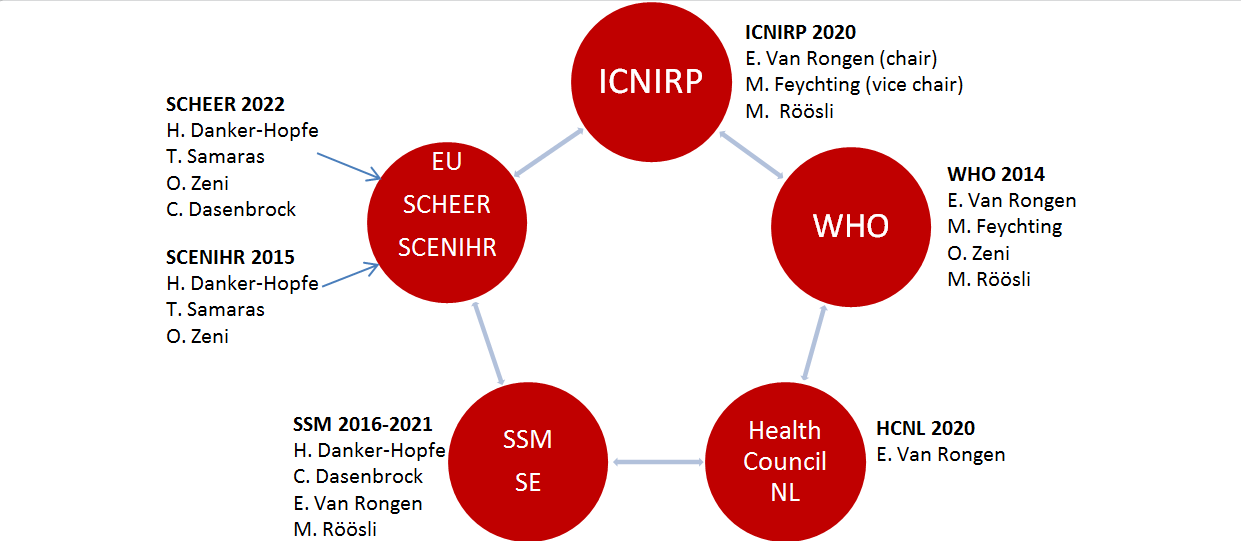
This ICNIRP cartel of experts promoting opinions favorable to the telecommunications industry was also described by journalists from Investigate Europe in 2019.
Lack of scientific basis
None of these reports provide any evidence that the ICNIRP limits are safe for long-term whole body exposure from base stations, as claimed for instance in this newspaper article. The burden of proof has consistently been shifted from the telecom companies to the public. There has been no requirement for them to show research demonstrating that chronic whole-body exposure to WiFi, 3G, 4G and 5G, individually or in combination, thus corresponding to real life exposure, is not harmful to health. That alarming information is constantly omitted from propaganda articles about the suggested “safety” of the ICNIRP guidelines.
This means that there is no scientific basis for claiming that ICNIRP limits protect against health risks in real life exposure situations. Maria Feychting, former vice chair of ICNIRP, was asked what research would show that whole-body exposure to 5G, 4G, 3G, WiFi in combination or individually over an extended period of time (at least one year) does not cause adverse health effects in humans at 24-hour exposure at the ICNIRP limit of 10 W/m2 averaged over 6 minutes or even at levels up to 1000 times lower. She could not provide one single reference to such studies.
The requested scientific evidence showing that the ICNIRP limits protect against harmful health effects from chronic exposure below the ICNIRP limits does not exist.
Sources:
https://www.stralsakerhetsmyndigheten.se/publikationer/rapporter/stralskydd/2005/200501/
https://www.fortunejournals.com/articles/aspects-on-the-international-commission-on-nonionizing-radiation-protection-icnirp-2020-guidelines-on-radiofrequency-radiation.pdf
https://www.icnirp.org/cms/upload/publications/ICNIRPrfgdl2020.pdf


